Varieties
Apricot Agouti
To be a pale apricot, evenly ticked with silver guard hairs. Undercolour to be ice blue down to the skin. Belly colour to be a pale cream. Foot colour to match top. Eyes Red.

Bareback
The hood shall be unbroken, covering the head, throat, chest and shoulders, except in the case of light coloured bareback varieties where a pale coloured throat is permissible. The remainder of the body to be white. The edges of the hood shall be clear cut and devoid of brindling. The white area shall be pure and devoid of any yellowish tinge or staining.

Blue Point Himalayan (includes both eye colours)
Body colour to be white, free from stains and even throughout. The points to be a medium smokey blue. Eyes Red or black. Note – Colour Areas:
- Face – not to extend upwards from the eyes.
- Ears – not to extend downwards from the base.
- Forelegs – not to extend upwards beyond the elbows.
- Hind legs – not to extend upwards beyond the ankle.
- Tail – not to extend beyond the tail root.
- Feet – colour to be solid throughout, devoid of any white.

Cinnamon Chinchilla
Top colour light brown, caused by the intermingling of brown guard hairs over a pearl white ground. The whole to give a pale speckled sandy appearance.
Undercolour midgrey/brown, intermediate section pearl, tips brown. The entire underside to be white with a clear demarcation between top colour and belly. Head markings may be present or absent. Where present either a blaze or a headspot to be acceptable.
Headspot: Headspots to be centrally placed on the rat's forehead and no bigger than the rat's eye.
Blaze: This is to be a wedge shaped symmetrical blaze of white starting at the nose and extending up the face to the forehead. The blaze to cover the whisker bed and to taper to a fine point midway between the eyes and the ears. Not to extend to the cheeks or the eyes.
Forelegs to be white to half their length, backfeet to the ankle (hock or tarsal bone). Tails to be pied. Eyes black.
Faults: Drags, skewed or misshapen blazes, uneven or over large headspots, top colour too yellow.

Coffee
To be a rich creamy caramel throughout, from tips of the fur down to the skin. Colour to be even as possible, devoid of dinginess, white hairs or patches. Foot colour to match top.

Cream Agouti
To be a mix of mid grey ticking over a mid cream ground, with no suggestion of blue or brown tones. Ticking to be darkest along the back and fade down the sides to the pale cream belly. Fur on the face to be lighter on the whisker bed and around the eyes. Eyes black.
Faults: Rusty patches, white toes, darker points on the nose, tail root and feet.

Essex Capped
The top of the head with the exception of the nose tip and the pattern to be coloured with the colour to extend a short way behind the ears. The rest of the rat to be white. Nose tip to be white, white triangle between the eyes pointing rearwards and with a white line running from the point of the triangle to the white on the nape of the neck. As with the related Essex variety, colour paling is normal for this variety and not a fault.
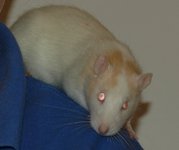
Havana
To be a warm rich brown. Eye colour mid ruby, to harmonise with coat colour.
Genetics: a/a B/b m/m R/r

Havana Agouti
To be a light sandy brown caused by the intermingling of light brown ticking over a light fawn ground. Belly to be pale silver, undercoat light brown grey. Foot colour to match top. Eye Colour mid to light ruby.
Serious faults: Dark eye colour. Colour must not conform to the standard for cinnamon.

Hooded Downunder
The hood: The hood should be unbroken and clean cut covering the head, throat, chest and shoulders except in the case of light coloured rats where a pale throat is normal. The hood shall be continuous with the saddle, extending down the spine to the tail with as much of the tail coloured as possible.
The saddle: The saddle width shall be 2 - 3.5 cm in the adult (proportionately smaller in the kitten) , as even as possible and unbroken.
Under: the belly stripe should be 2 -3.5 cm wide and unbroken (proportionately smaller in the kitten). Side areas should be devoid of spotting.
Colour: Colour to conform to a recognised colour variety. The white areas shall be devoid of a yellowish tinge or staining.
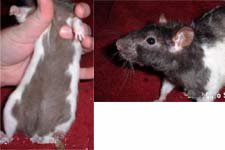
Merle
Merle rats may be shown in pearl and cinnamon pearl. The unique feature is a pattern of dark splash-spots distributed evenly throughout the entire lighter background colour so as to resemble a merle dog. The markings should be numerous and distinct. Eye colour black.

Powder Blue
To be a pale dove blue colour, with pale silver base fur. Pale silver underbelly. Should be distinctively different to that of the slate colour of the blue rat. Colour to be as even as possible, devoid of dinginess, white hairs or patches. Foot colour to match top. Eyes Black or Ruby.
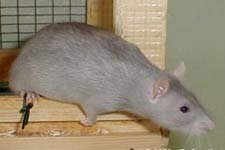
Pink Eyed Ivory
Body colour to be very pale creamy white all over with no odd coloured hairs or patches. Ears and tail to be pink. Eyes pink.

Russian Buff
To be a pale greyish beige. Faint light speckling or a subtle ticked effect (heathering) is usual for this variety and is not a fault. Colour to be level throughout. Not to be confused with standard Buff or Platinum. Belly colour to match top, undercolour light greyish beige to the skin. Coat to be short and thick - a long coat or a coat similar to that on other varieties (excluding rex) to be a serious fault. Eyes dark ruby to black.
Faults: Dark, dull or too warm top colour. Light ruby eyes.
Severe Faults: Very pale or dark patches or prominent white eye circles.
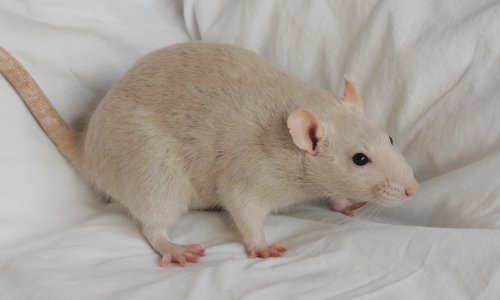
Russian Burmese
To be warm, mid grey, devoid of dinginess, silvering, or patches, with distinctly darker points of the same shade. Faint light speckling or a subtle ticked effect (heathering) is usual for this variety and is not a fault. Eyes black or very dark ruby.

Russian Dove Agouti
A blend of warm pinky grey ticking over a light fawn ground. Heathering of the ticking is normal for this variety and not a fault, Undercolour grey to the skin, foot colour to be grey, belly colour light silver. Eyes black.

Russian Pearl
To be a mid silver, with a creamish undercolour. The majority of hairs to be pearl tipped with grey, indispersed with occasional grey hairs. The top coat must be short and thick with a slight metallic sheen. Belly fur to be a pale creamy grey. Foot colour pale grey. Eyes Black.

Satin
The satin shall have a high sheen coat resulting in a satin like or metallic gloss. The colour may be that of any recognised variety. Satinization will appear to increase the intensity of any colour and this should be taken into account.

Turpin
Marked rat with colour confined to defined areas of the face and a wide band of colour sprinkled in a wide band down the back. Face (similar to the roan) - two triangles of colour from the ears to points at the eyes. Triangles to meet between the ears. This colour and the colour along the back to be mixed with white to give the appearance of the colour being lightly sprinkled onto the white background. The colour on the back to be present in a wide band.
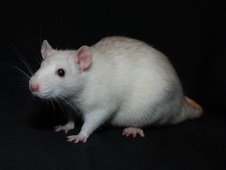
Variegated Downunder
The head and shoulders to be of a distinct colour with a white spot or blaze on the forehead. Where a spot is present this should be centrally placed on the forehead, round or oval in shape and no bigger than the rat's eye. Blazes are a wedge shaped symmetrical blaze of white, starting at the nose and taper to a fine point midway between the eyes and ears. Markings not to extend onto the cheeks or the eyes. The rest of the upper portion (back, sides and tail) of the rat's body to be white, evenly marked with patches and flecks of distinct colour, the colour to conform to a recognised colour variety. Underside should have a broken marked centre line down the belly. Side spots desirable.
Faults: rusty patches, white toes, darker points on nose, tail root and feet.
